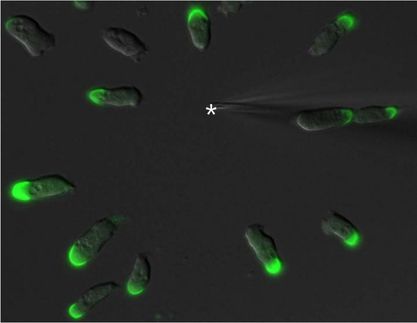Cohesin: a cherry-shaped molecule safeguards cell-division
Advertisement
The cohesin molecule ensures the proper distribution of DNA during cell division. Scientists at the Research Institute of Molecular Pathology (IMP) in Vienna can now prove the concept of its carabiner-like function by visualizing for the first time the open form of the complex. The journal SCIENCE publishes the new findings in its current issue.
The ring-shaped cohesin complex ensures that each round of cell division yields two daughter cells with identical sets of chromosomes. The peculiar molecule and its function were discovered in Kim Nasmyth’s lab at the IMP in 1997. The conclusions that the researchers drew from their observations back then were unexpected. A molecule shaped like a ring was proposed to hold the two nascent DNA-strands together - much like a rubber band - until the exact moment had arrived for separation. Only then would the ring snap open and release the two copies of chromosomes on which the genetic information is stored.
In the following years, this mechanism was not only confirmed but further and far-reaching functions of cohesin were discovered, such as its importance for DNA damage repair and for the structure of chromatin. However, cohesin itself was never seen in action. In the living cell, the opening of the ring is an extremely fast process and doesn’t last long enough to be captured.
Pim Huis in ‘t Veld, a former PhD-student in the lab of IMP-director Jan-Michael Peters, has now found an indirect way of visualizing cohesin at the moment when it opens up and releases DNA. After toiling with the problem for five years, he is now able to construct a synthetic cohesin molecule from its molecular building blocks. The method involves infecting cultured ovarian cells from the army worm with baculoviruses to engineer the necessary proteins.
By inserting mutations, Pim Huis in ‘t Veld was able to force cohesin- into its open form and remain there. A transmission electron microscope and a 72,000-fold magnification then did the trick and cohesin’s open state was for the first time captured on screen. The images show tiny structures with two thread-like arms, connected by a molecular hinge. A more poetic association that comes to mind is that of a pair of ripe cherries.
For researchers in the field of cell and structural biology, the confirmation of the postulated mechanism of action is an important step towards understanding the details of cell division. The US-journal SCIENCE therefore features the new findings prominently in its current issue, flanked by a complementing article from the labs of Kim Nasmyth (Oxford) und Jan Löwe (Cambridge).
Elucidating the function of Cohesin is also highly relevant for human medicine. Jan-Michael Peters explains why: “A number of tumors are associated with mutations in cohesin genes, among them certain forms of leukemia and bladder cancer. Mistakes in cell division, caused by malfunctioning cohesin, can also lead to chromosomal aberrations like trisomy 21 (Down syndrome). Even the age-related decrease in female fertility and a high percentage of spontaneous miscarriages are attributed to cohesin defects.”


























































